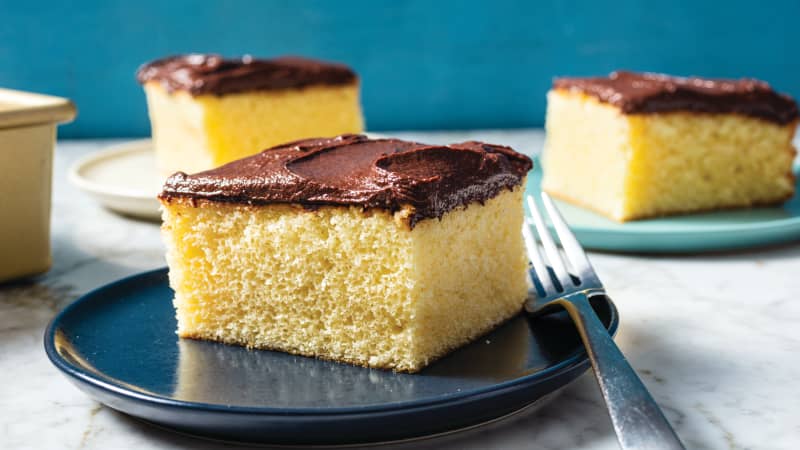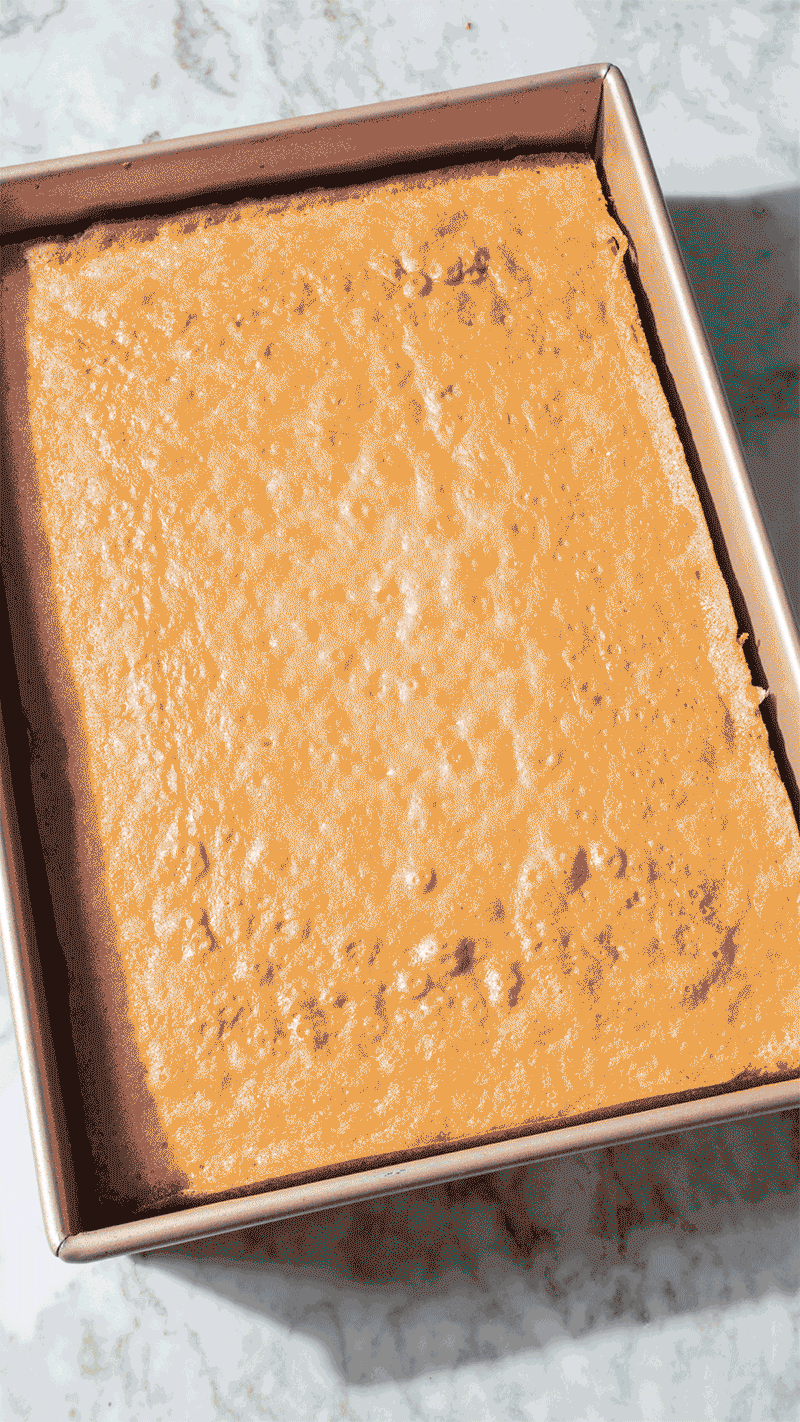Yellow sheet cake is a darling of American desserts: It’s classic, universally liked, and just right for serving by the square. And yet it never seems to realize its full potential. The crumb is usually OK—moist and relatively coarse—but there’s no reason that a sheet cake can’t have a truly special texture. I’m talking about an extraordinarily fine, uniform crumb, the kind so tender that it practically dissolves on the palate. I wanted to combine this plush texture with fresh, buttery flavor. And for a cake this good, only a rich, creamy chocolate frosting would do.
Next-Level Yellow Sheet Cake
Published Aug. 5, 2020.

Formula One
The unique crumb I’m referring to shows up in what is known as a “high-ratio” cake. Most cake formulas are low ratio, meaning they have slightly less sugar by weight than flour, but some are high ratio, meaning—you guessed it—they have more sugar by weight than flour. And that’s key because sugar doesn’t just sweeten a cake; it also adds moisture and makes the crumb finer and more tender.
Quick experiment: I increased the sugar in a low‑ratio yellow cake recipe by 20 percent so that it outweighed the flour. Quick result: The cake collapsed right after I took it out of the oven. This is where bleached cake flour, the signature ingredient in high-ratio cake, comes in. Bleached cake flour differs from all-purpose flour in three ways: It’s more finely milled, it has less protein, and (surprise) it’s bleached. The first characteristic helps the flour disperse and absorb moisture more evenly, and the second helps make cakes tender. But it’s the bleaching that’s really important here. Although it whitens the flour, that’s not the primary objective: It also alters the starch in such a way that the cake doesn’t fall under the weight of extra sugar, liquid, or fat (see “Why Use Bleached Cake Flour?”).
Why Use Bleached Cake Flour?
It’s vital to used bleached cake flour for this cake. That’s because exposure to chlorine gas (or other bleaching methods) not only whitens flour but also alters its starch in such a way that the cake doesn’t shrink or fall once it is baked. It works in two ways: First, bleaching makes the starch in flour better able to absorb the extra sugar (which dissolves during baking), liquid, and fat present in high-ratio cakes such as this one, thus creating a thicker batter that can hold tiny air bubbles to support a fine, plush texture. Second, bleaching promotes the gelatinization of the starch in the flour, which also develops structure in the crumb.
I searched for a few high-ratio cake recipes, and the one I liked best went like this: Cream 121/4 ounces of sugar together with butter; whip in the eggs and the liquid (which in this case was buttermilk with a generous amount of vanilla); and then mix in the dry ingredients—9 ounces of bleached cake flour, plus baking powder, baking soda, and salt. Pour the batter into a greased and floured pan and bake it for about 30 minutes.
The vanilla flavor, so important to the subtle profile of a yellow cake, was suitably strong. But the crumb was a bit dry and crumbly, and I noticed something odd with how it looked as I served it.
Shady Results
When I cut into the cooled cake, I found damp, subtly shaded areas in the crumb, mostly toward the bottom half of the cake. What was happening? Turns out, some of the liquid in the batter was settling as it baked.

An emulsifier would help the liquid in the cake stay evenly distributed throughout baking. Luckily, I always keep a superstrong emulsifier in my fridge. You probably do, too—it’s called egg yolk. Yolks contain lecithin, a powerful emulsifier. When I added two extra egg yolks to my batter, the “shadow” that had marred my earlier cake disappeared.
I now had quintessential yellow cake flavor: all butter and vanilla and egg yolks. But the crumb was still a little dry and a little more open and crumbly than I wanted.
Mixing Matters
To address the dryness, I replaced some of the butter with vegetable oil. Not only would this produce a moister cake, but the cake would stay that way for longer (see “Two Fats, Two Benefits”). But this meant that I needed to reconsider my mixing method. The conventional creaming method requires beating the butter and sugar together until the mixture is light and fluffy before adding the remaining ingredients. Half the fat in my new cake was liquid (oil), which can’t hold air the way that solid fat (butter) can, so creaming was no longer viable. But reverse creaming? That’s different.
Two Fats, Two Benefits

You need both
Butter provides flavor; oil keeps the cake moist.
Reverse creaming is simple. Just combine the sugar, flour, leavening, and salt in the bowl of your stand mixer, and then add the fat. Mix it until it’s combined. Next, add the liquid and eggs and beat the heck out of it, turning up the speed once the mixture is combined. Only a small amount of air gets incorporated during mixing, resulting in a superfine texture. It worked beautifully. The cake had a tender, moist, and fine-grained crumb. On to the frosting.
Frosting on the Cake
This cake is especially perfect for casual summer meals, so it was important that the frosting could stand up to warm, humid weather. American chocolate buttercream, the simple mixture of butter, confectioners’ sugar, milk or cream, cocoa powder, and/or melted bittersweet chocolate, holds up well, but I had reservations. Its fine sugar crystals can sometimes feel a little coarse on the tongue.
Creamy, Dreamy—and Sturdy—Frosting

American chocolate buttercream, the sweetly nostalgic mixture of softened butter, milk or cream, confectioners’ sugar, cocoa powder, and/or melted bittersweet chocolate, holds up well in warm weather, but it can have a gritty texture because there’s not enough moisture in the mixture to dissolve the very fine sugar crystals. To smooth things out for our version, we beat the sugar, cocoa powder, and softened butter with a little hot water instead of milk, which helps dissolve most of the sugar. Once the mixture is combined, we add melted bittersweet chocolate for even more depth.
I came up with a solution: In addition to softened butter, I beat 1/4 cup of hot water (instead of milk) into the confectioners’ sugar and cocoa powder, which dissolved some of the sugar crystals for a smoother frosting (see “Creamy, Dreamy—and Sturdy—Frosting”). When the butter was well incorporated, I added a couple ounces of melted bittersweet chocolate for deep, dark flavor. At first, the frosting looked far too loose to be spreadable, but after sitting for a few minutes, it was thick and creamy, ready to be smoothed over the top of my cake.
This classic dessert had been upgraded in exactly the way that I had envisioned: Here was a tender, fine-textured cake full of butter and vanilla, topped with rich chocolate frosting.

